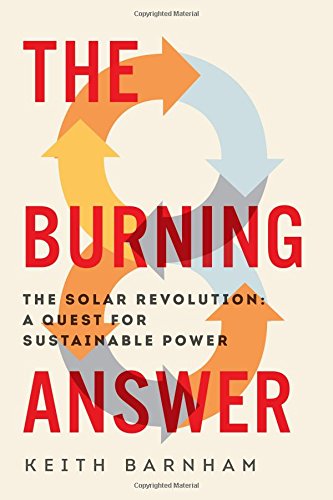
The Burning Answer
- اطلاعات
- نقد و بررسی
- دیدگاه کاربران
نقد و بررسی

June 29, 2015
In with renewables and out with everything elseâespecially nuclear powerâis the message of this tendentious "manifesto" on energy policy. Barnham, a British physicist who developed a solar cell, QuantaSol, insists that "solar" powerâwhich in his usage includes not just photovoltaics but wind power, hydro-power, bio-gas, and other sources that derive circuitously from the sun's energyâis the only sustainable energy that can save us from climate change. He begins with lengthy discussions of the physics of energy technologies, pitched at laymen but using maladroit metaphors that are simplistic yet difficult to follow. (Buzz Lightyear at a children's party is a favorite image.) He moves on to inadequate, rose-tinted treatments of the practical economics, performance, and reliability of renewable energy systems, glibly skating past their drawbacks; his analysis of the effect of photovoltaics on wholesale electricity prices is especially garbled and misleading. Much of the book is given over to anathemas against nuclear power that are similarly ill-considered and biased. (He numbers the element plutonium and the humble neutron among "the villains of our story.") Barnham's sloppiness with facts, murky explanations, dotty conceits ("We don't know if Stonehenge is saying nuclear waste is stored there"), and blatant propagandizing make this one of the worst accounts of energy policy to appear in recent years.

March 15, 2015
Humans once obtained all energy directly from the sun and will do so again, writes Barnham (Emeritus, Physics/Imperial Coll. London) in an optimistic, heavily science-based polemic. The author begins with a dense, not always relevant history of 20th-century nuclear physics, but he also includes a primer on quantum theory that explains the solar cell and the closely related transistor invented following World War II. Aware of the transistor's possibilities, the American military massively supported research that led to the digital revolution that continues to expand at an astonishing rate today. The military and government showed less interest in solar cells, so development lagged, but Barnham maintains that an energy revolution began around 2000-mostly in Europe. In the second part of the book, the author describes how this is playing out with the necessary inclusion of wind and biogas electricity generators. Americans who assume that solar and renewable energy are laudable but impractical will be surprised by Barnham's extensive evidence of how well other nations are doing. Germany and Denmark aim to provide all electricity through renewables in 2050; many smaller nations are doing even better. "Their work is further evidence confirming one important message of this book: an all-renewable electricity supply is achievable quickly, cheaply, and safely," writes the author. "What is missing is the political will." Nuclear power remains exorbitantly expensive; the industry would vanish without massive government support. Oil, coal, and gas producers receive generous tax breaks and subsidies, and they show their gratitude. Barnham concludes with a cheerful prophecy of progress over the next decades, as well as not-entirely-convincing advice on how British and American readers can persuade their leaders to sacrifice selfish interests and join the revolution. An admirable addition to the growing genre maintaining that global warming may not lead to Armageddon.

April 15, 2015
Barnham (emeritus, physics, Imperial Coll. London) makes an impassioned case for solar energy as the best solution to the threats of global warming, fossil-fuel depletion, and nuclear power. He's a gee-whiz kind of popular science writer, one with a knack for analogy. The book begins with a fascinating survey of the discoveries that led to the invention of semiconductor and photovoltaic cells; the work of Michael Faraday, James Clerk Maxwell, Albert Einstein, et al, receives clear, often witty explanation. Next, Barnham considers the politics surrounding energy and explains why Germany is leading the world in solar power generation; he also ventures a short answer as to why research into solar energy has been slow (the military hasn't been interested). Barnham closes the work by describing some of the latest solar technologies and, since "people power" is the force behind any revolution, it is here he delivers his manifesto. VERDICT The author makes some big claims about the viability (and necessity) of solar energy, and while he seems oblivious to the strength of NIMBYism (Not In My Backyard), many readers will be inclined to agree with him. He persuades not with charts and graphs but with the power of his storytelling and his passion for science.--Robert Eagan, Windsor P.L., Ont.
Copyright 2015 Library Journal, LLC Used with permission.

April 15, 2015
Dozens of books have been published in recent years touting the environmental benefits of solar energy, but few display more unbridled enthusiasm for the technology than this rousing manifesto from Barnham, a physics professor at London's Imperial College. As a springboard to explaining some truly revolutionary ideas here, Barnham cites a lesser known equation of Einstein's, E = hf, which shows the equivalency between light and electricity. Einstein's more famous mathematical pronouncement, E = mc2, led, of course, to nuclear power, which Barnham has little good to say about, whereas the first equation made possible both computer chips and solar cells. Barnham spends much of the book tracing the history and politics of energy production, with side detours into such related topics as semiconductors and electric cars, before pointing the way toward a sun-based energy policy that includes using his own super-efficient silicon cells and breakthrough methods of CO2 storage. Barnham's work will inspire everyone interested in green energy, from business people to consumers to activists, and deliver a body blow to those still determined to exploit climate-damaging fossil fuels.(Reprinted with permission of Booklist, copyright 2015, American Library Association.)




دیدگاه کاربران